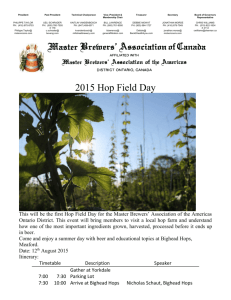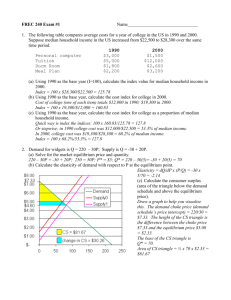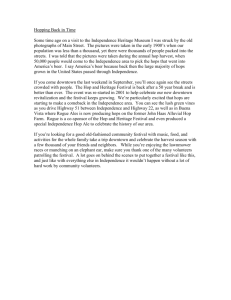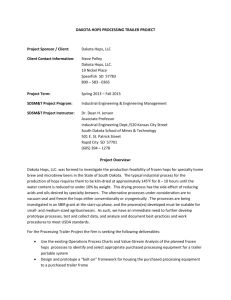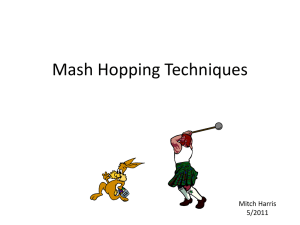Continues to subtract twos when calculating twenty divided by two
advertisement
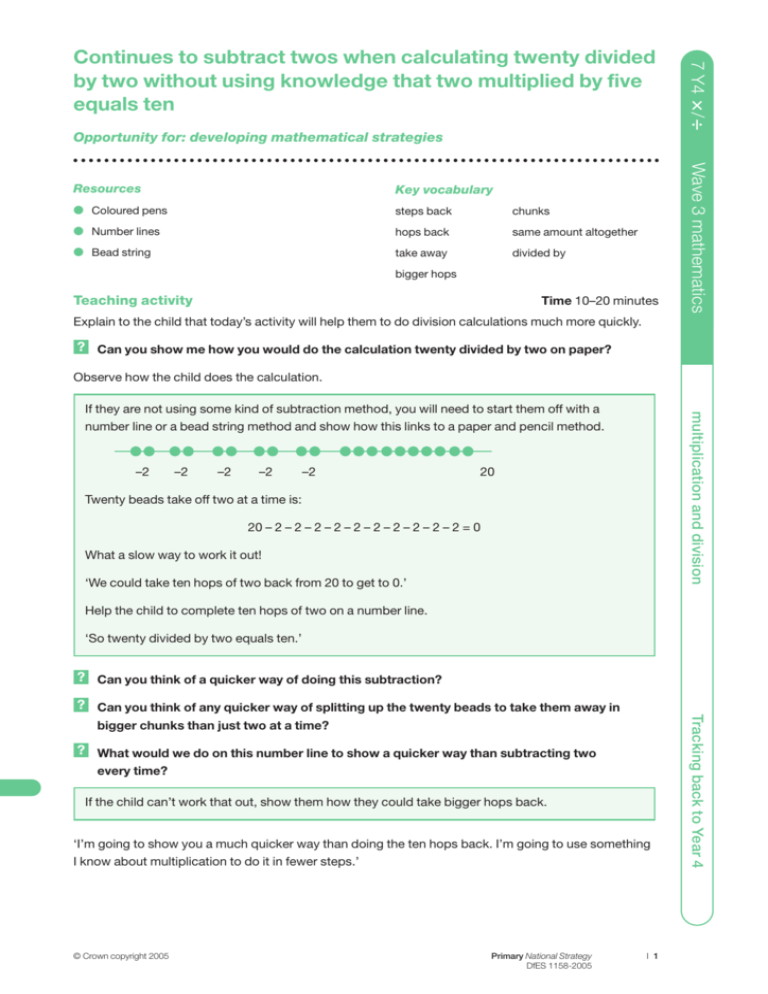
7 Y4 / Continues to subtract twos when calculating twenty divided by two without using knowledge that two multiplied by five equals ten Opportunity for: developing mathematical strategies Key vocabulary ● Coloured pens steps back chunks ● Number lines hops back same amount altogether ● Bead string take away divided by bigger hops Teaching activity Time 10–20 minutes Wave 3 mathematics Resources Explain to the child that today’s activity will help them to do division calculations much more quickly. ? Can you show me how you would do the calculation twenty divided by two on paper? Observe how the child does the calculation. –2 –2 –2 –2 –2 multiplication and division If they are not using some kind of subtraction method, you will need to start them off with a number line or a bead string method and show how this links to a paper and pencil method. 20 Twenty beads take off two at a time is: 20 – 2 – 2 – 2 – 2 – 2 – 2 – 2 – 2 – 2 – 2 = 0 What a slow way to work it out! ‘We could take ten hops of two back from 20 to get to 0.’ Help the child to complete ten hops of two on a number line. ‘So twenty divided by two equals ten.’ ? Can you think of a quicker way of doing this subtraction? ? Can you think of any quicker way of splitting up the twenty beads to take them away in ? What would we do on this number line to show a quicker way than subtracting two every time? If the child can’t work that out, show them how they could take bigger hops back. ‘I’m going to show you a much quicker way than doing the ten hops back. I’m going to use something I know about multiplication to do it in fewer steps.’ © Crown copyright 2005 Primary National Strategy DfES 1158-2005 I 1 Tracking back to Year 4 bigger chunks than just two at a time? Let the child fill in the five small hops of two on your number line. ‘One big hop of five lots of two is ten.’ –10 –10 ▲ ▲ Five hops of two are ten 0 –2 ▲ –2 ▲ –2 ▲ –2 ▲ –2 ▲ 7 Y4 / ‘I know that two multiplied by five equals ten, so hops of two five times is ten. So I’m going to take an enormous step back and get from 20 all the way to 10. That has the same value as taking five little hops of two each.’ 10 20 Repeat, putting in five more little hops of two from 10 to 0. ‘So I could do the division twenty divided by two very slowly by taking away two at a time, or I can use my multiplication tables and take away five lots of two all in one go to get to 10, then another five lots of two to get to 0.’ ? How many hops of two have I taken away? ? How much did I take away altogether with those two big hops? Support the child by talking it through again, perhaps going over the hops in different colours. ? When we did all these little red hops, how many were we taking away at a time? (Two) ? When we did the bigger and quicker green hops, what were we taking away each time? (2 5) ? So did we take away the same amount in the end? Explain it to me. Use the number line again, or the bead string, to show that taking away five lots of two each time is quicker. ‘We took away five lots of two then another five lots of two, so in the end we have the same answer. Twenty divided by two is five hops of two and another five lots of two. That is ten lots of two altogether: the same as our slower method.’ ‘Now I am going to hide the drawing we did and I want you to talk me through it as you do it again. Use the red pen for the little hops and the green pen for the big hops.’ ? How many little hops of two are there from 20 to 0? (Ten.) ? How many big hops of 2 x 5 = 10? (Two.) ? How do you know? 20 2 = 10 ‘Today we were finding ways to make division a bit quicker and we did that by taking bigger hops back on the number line.’ ? What do you think you need more help with? 2 I Primary National Strategy DfES 1158-2005 © Crown copyright 2005 Continues to subtract twos when calculating twenty divided by two without using knowledge that two multiplied by five equals ten Opportunity for: working systematically Slow way, fast way Time 10–20 minutes Resources Key vocabulary ● Coloured pens steps back chunks ● Number lines hops back same amount altogether ● Bead string take away divided by ● 100-square and/or Multiplication grid 1 (Resource bigger hops sheet 35) Teaching activity ‘We’re going to look at a slow way to work out twenty-four divided by two and a fast way to do it. Show me how you would work out twenty-four divided by two on paper.’ Build on what the child says and does. If the child doesn’t use a method that can be extended into taking larger chunks, demonstrate a very slow way of working out how many twos make twenty-four. ‘I start with twenty-four and I can take away two at a time like this: 24 –2 is 22 –2 is 20 . . . Continue on down the page showing how slow it is to take away two each time. But be positive about getting to the right answer! ? How many lots of two did we have to take away altogether to get to zero? (Twelve – let the child count them.) ? So what is the answer to twenty-four divided by two? 24 2 = 12 There are 12 twos in 24 ? Can you remember that last time we took away bigger chunks at a time? Tell me what you remember about this. © Crown copyright 2005 Primary National Strategy DfES 1158-2005 I 3 7 Y4 / Spotlight 1 ? Do you remember how easy it is to say the ten times table? ‘Look at this 100-square (or multiplication grid) and tell me how many twos there are in twenty.’ Once the child is sure that there are ten twos in twenty, demonstrate (with a green pen perhaps) how to take one enormous step back of ten lots of two. ‘One enormous hop of ten lots of two and two more little hops of two make twenty-four.’ –20 ▲ 7 Y4 / Ask the child to draw a number line and show the slow hops of two back from 24 to 0 (in red pen perhaps). Ten little hops of two are twenty Two little hops of two –2 0 –2 2 –2 –2 –2 –2 –2 –2 –2 –2 4 –2 –2 24 ‘So I can work out how many twos there are in twenty-four by taking twelve little steps, or one enormous hop of ten lots of two, then two more little hops of two.’ Support the child by going over the calculation again. Clarify that you get the same answer doing it the quicker way because you still count back twelve lots of two. Taking a big hop makes it quicker. You need to make the link from the number line hops to the earlier vertical recording on paper. 24 – 20 is 4 –2 leaves 2 –2 0 So 24 2 is 12. Ten hops of two One hop of two One hop of two Twelve hops of two altogether ‘We subtracted a bigger chunk doing it this way. Instead of doing little chunks of two each time, we did one big chunk of twenty then two more little chunks.’ ? Could we have done it another way? ‘We’ll do some more of this next time. Once you understand this method of taking larger chunks, it is going to help you to be much quicker at division.’ 4 I Primary National Strategy DfES 1158-2005 © Crown copyright 2005 Continues to subtract twos when calculating twenty divided by two without using knowledge that two multiplied by five equals ten Opportunity for: making a problem easier Go for tens Time 10–20 minutes Resources Key vocabulary ● Coloured pens steps back chunks ● Number lines hops back same amount altogether ● Bead string take away divided by ● 100-square and/or Multiplication grid 1 (Resource bigger hops sheet 35) Teaching activity ‘We are going to do some counting back today, taking big steps, and this is going to help you to get faster at doing division.’ Show the child a bead string with twenty beads and a number line with 20 marked. ? How could you do twenty divided by two, slowly with lots of little hops along the number line and moving two of these beads at a time? If the child can’t do this, help them to draw in the steps of two and count along the bead string in twos. … Show the child how their counting back of beads and their hops back of two relate to a long written method. 20 (2 1) –2 18 (2 1) –2 16 –2 (2 1) Continue this down the page, taking away ten lots of two altogether. ? Do you know what ten lots of two are? Help the child to refer to a multiplication grid or to a 100-square if necessary. ‘Instead of that very big long calculation taking off one two at a time, I could take away ten lots of two all in one big hop back.’ 20 (2 10) – 20 0 ‘So twenty divided by two is ten. There are ten twos in twenty.’ © Crown copyright 2005 Primary National Strategy DfES 1158-2005 I 5 7 Y4 / Spotlight 2 7 Y4 / If the child needs more support to understand this, show the slow counting back in ten hops of two, and the faster counting back of ten lots of two in one big step of twenty. ‘We can do ten little steps of two to get from twenty to zero.’ –20 ‘Or we can take a big step of ten lots of two.’ –2 2 10 = 20 0 18 20 ‘There are ten twos in twenty, so twenty divided by two is ten. ? Work out thirty divided by five on a number line and do it without taking lots of little steps of five. If the child can’t think of how to do that, suggest that they draw a number line and put the numbers on and have a think about it while you write out the slow way of doing the calculation all down a page. 30 While you write: –5 (5 1) 25 –5 (5 1) . . . show the child what you are doing and if they cannot think of any bigger hops to make, they could make a little hop of five as you work out the calculation. –5 0 –5 5 –5 10 –5 15 –5 20 –5 25 30 ? How many hops of five did we need to get from 30 to zero? ? So how many fives are there in thirty? How can we write that down? 30 5 = 6 ‘Ten is a very useful number when we are trying to hop back in bigger steps. Look carefully at your six hops of five.’ ? Could you take another colour of pen and make bigger steps back? ? What size steps could you make? Help the child to move towards three hops of ten, or some other large hop. Go back to the long calculation you did earlier and show how it can be done much more quickly. 6 I Primary National Strategy DfES 1158-2005 © Crown copyright 2005 7 Y4 / 30 –5 (5 x 1) 25 –5 (5 x 1) . . . This can also be written as: 30 subtract 10 leaves 20 subtract 10 leaves 10 subtract 10 leaves 0 (5 x 2) (5 x 2) (5 x 2) (5 x 6 altogether) 30 – 10 20 – 10 10 – 10 0 So 30 5 = 6. ? How many big steps of ten? (Three) ? How many little steps of five? (Six) ? Why do you think it took half the number of hops when we hopped back in tens? If the child is finding it difficult to see the relationship between these hops, go back to the number line hops. Demonstrate how a hop of five is half the size of a hop of ten. ‘So with hops of ten we only need half the number of hops.’ Spotlight 3 Continues to subtract twos when calculating twenty divided by two without using knowledge that two multiplied by five equals ten Opportunity for: trying alternative strategies Bead string fives Time 15–20 minutes Resources Key vocabulary ● Coloured pens steps back chunks ● Number lines hops back same amount altogether ● Bead string take away divided by ● Multiplication grid 1 (Resource sheet 35) bigger hops ● Place value (arrow) cards © Crown copyright 2005 Primary National Strategy DfES 1158-2005 I 7 7 Y4 / Teaching activity ‘Today, we are going to use a bead string and a number line to do a division. We are going to work out sixty-six divided by five.’ ? If we were going to do this division by taking lots of little steps back from sixty-six, what size would be a good size for the little steps? (Steps of five) If the child is unsure, show the calculation 66 5 and ask the child to read it carefully: ‘sixty-six divided by five.’ ‘The size of the steps is five.’ Show on the bead string how you could count back five beads at a time from sixty-six. ? If it was sixty-six divided by seven what would the size of the steps be? (Seven) ? If it was sixty-six divided by eight what would the size of the steps be? (Eight) Do a few more examples, if needed. ‘For sixty-six divided by five we could do lots of little steps of five, but, instead of that, we are going to try to take at least one very big step first’. ? What big step do you think you could take? Help the child to think about the five times table, either looking at a multiplication grid or reciting the five times table. If they don’t suggest a suitable first large step, you could suggest a step of ten lots of five or counting back fifty beads on the bead string. 5 10 = 50 5 3 = 15 0 1 16 66 Demonstrate on the bead string and the number line, sliding ten lots of five beads, or one large step of fifty on the number line, three lots of five beads as a smaller step of fifteen and one bead is left over. If the child seems to be having trouble with splitting sixty-six into fifty and sixteen, you might find it helps to use place value cards. 6 6 5 0 1 6 ? How many groups of five have been slid along the bead string? Or can you count them on the number line? There have been ten lots of five and three lots of five, so sixty-six divided by five is thirteen remainder one. ? Can you write that down starting with the sixty-six and doing a division calculation? Let the child do this in their own way and you can build on that at a later date if the method is quite slow. Comparing their method with another more efficient method in the class might be the best way to move the child on. ‘Can you do sixty-six divided by five in a really efficient way? Whose method is quickest?’ 8 I Primary National Strategy DfES 1158-2005 © Crown copyright 2005 Continues to subtract twos when calculating twenty divided by two without using knowledge that two multiplied by five equals ten Opportunity for: reasoning about numbers Three steps only Time 15–20 minutes Resources Key vocabulary ● Paper and coloured pens steps back chunks ● Number lines hops back same amount altogether ● Bead string take away divided by bigger hops Teaching activity ‘We are going to do some divisions today, and I want you to do them without using more than three steps on the number line.’ ? Can you work out forty-two divided by three? ? What could be your first big step? If the child seems unsure, ask them first how big the little steps would be in that calculation. (The small steps are three.) Remind them of how easy it is to take steps ten times bigger. ? What is ten times bigger than three? (Thirty) ‘You can record what you do in any way you want, but you mustn’t take more than three steps back.’ ? If you take your first big step of thirty, what number will you get back to? Make sure they are now back to 12. –30 Ten lots of three 12 42 ‘You must now get to 0 but you only have two steps left.’ Support the child to work out either one more step of four lots of three, or two more steps of two lots of three. ? What is the answer to forty-two divided by three? (Fourteen) How do you know? If you have time, you could do another example such as seventy-two divided by five. (This one has a remainder.) ‘Remember you must do it in three steps or fewer.’ © Crown copyright 2005 Primary National Strategy DfES 1158-2005 I 9 7 Y4 / Spotlight 4 7 Y4 / ? What size steps would you take if you were taking lots of little steps? (Five) ? What very big step could you take? If the child is unsure, remind them again of the multiplication table for tens. One method might be to do ten lots of five, then four lots of five and there is a remainder of two. –50 –20 –2 0 2 22 72 (Some children might feel that they have done this in two steps because the remainder doesn’t make a whole step of five.) ? Do you think that you are starting to understand this quicker way of doing divisions? What do you need more help with? 10 I Primary National Strategy DfES 1158-2005 © Crown copyright 2005 Continues to subtract twos when calculating twenty divided by two without using knowledge that two multiplied by five equals ten Opportunity for: discussing and explaining Chunking chase Time 10–20 minutes Resources Check: does the child use key vocabulary? ● At least two players steps back chunks ● Large folders or books hops back same amount altogether ● Egg-timer or stopwatch take away divided by ● Rewards bigger hops Teaching activity This game, Chunking chase, can be played with children cooperating in pairs racing another pair. Children can hide what they are doing behind a big book propped open on the table. You can vary the numbers as children get more confident, starting with numbers that fit with taking a first large chunk of ten times the step size and leave no remainder, for example: 36 3 or 48 4 or 70 5 Children can move on to numbers where they might need to take more than one step of ten times the step size, for example: 54 2 or 78 3 or 92 4 Then they can move on to numbers that have a remainder, for example: 71 2 or 83 4 or 55 2 or 87 5 You can put the division calculations that you want the children to use in a bag, or just give them one calculation at a time for a 5-minute lesson. How to play 1. Players write down the division calculation. 2. The egg-timer will then be started and the players try to work out the calculation by chunking the numbers so that they can do it quickly. 3. The players record the division as a vertical calculation going down the page or as number line hops. 4. Every player or pair that works it out before the egg-timer runs out will win ten rewards. 5. Then players compare their methods and answers. 6. Players who have worked out the calculation correctly will win a further ten rewards. 7. Write down the score and keep it for next time. ? Could you have done that calculation a different way? ? Which way is best? Why? © Crown copyright 2005 Primary National Strategy DfES 1158-2005 I 11 7 Y4 / Spotlight 5: a learning check 7 Y4 / Variations ● Play with a stopwatch and write down how many minutes it takes. Players then score that many minutes and this becomes their ‘personal best time’. Next time they play the game they have to try to beat it! ● (You need to supervise this and it can take quite a long time to be ready to play.) Each player or pair makes up a division for the other player or pair. But they must know the right answer to any division they give another player! They must write this down first. Learning outcomes By the end of this set of activities children should be able to: ● use and understand connected mathematical vocabulary; ● tackle related learning tasks with increased motivation and confidence; ● take steps back along a number line in multiples of the step size; ● record in a vertical way, subtracting multiples of the step size; ● use their knowledge of multiplication to speed up their calculating; ● understand that chunking makes calculating faster. 12 I Primary National Strategy DfES 1158-2005 © Crown copyright 2005

